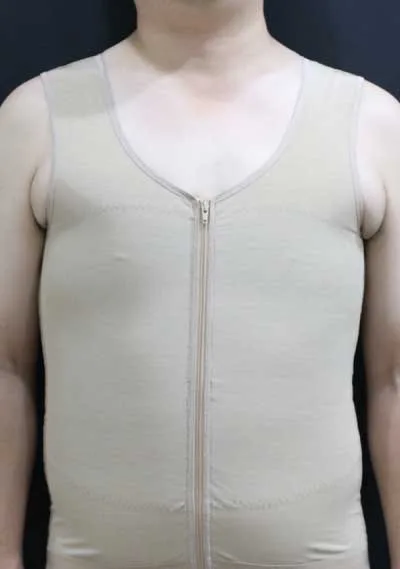– Why it matters and how to wear it right –
After undergoing gynecomastia surgery, many patients believe the hardest part is over. But in reality, postoperative care is just as important as the surgery itself — especially when it comes to wearing your compression garment.
This specially designed vest plays a crucial role in helping your chest heal smoothly, reducing swelling, minimizing adhesion (scar tissue sticking), and supporting the skin’s natural retraction. Without it, patients are at higher risk of developing skin folds, uneven contours, or even dimpling as the swelling subsides.

Why Is the Compression Vest Essential?
-
Controls Swelling (Edema): Post-surgical swelling is a normal reaction. The compression vest applies even pressure to reduce fluid buildup and helps your chest settle into its new shape.
-
Prevents Skin Irregularities: Without compression, your skin may sag or wrinkle as it heals. Consistent pressure promotes smooth reattachment of the skin to the chest wall.
-
Reduces Adhesions (Scar Tissue Sticking): Especially around the areola, underarms, and lower chest crease, tension from the garment can prevent tethering and indented scars.
-
Improves Comfort & Convenience: Compared to traditional bandages used in the past — which required daily replacement — the compression vest is easier to maintain, more comfortable, and offers better results.
How Long Should I Wear It?
-
Basic Protocol:
Wear the garment 24 hours/day for the first 2 weeks, then 12 hours/day for the next 2 weeks. -
Advanced Cases (Anchor Incision or Grade 3–4):
In cases requiring Anchor resection or Double incision methods, compression may be needed for 6 weeks or more, depending on your healing progress. -
While Traveling:
If you’re flying shortly after surgery (which is common for international patients), you must wear your compression vest during the flight. Changes in cabin pressure and limited mobility can worsen swelling, making the garment even more critical.
Cleaning & Care Instructions
-
Wash the garment by hand using mild detergent.
-
Air dry naturally or use a hairdryer on low setting if needed.
-
During drying time, you may leave the garment off temporarily — but ensure you wear it again as soon as it’s dry.
⚠️ Tips for Proper Fit & Effectiveness
-
Smooth out wrinkles:
Pull the vest downward to eliminate bunching around the underarms or inframammary fold. This helps reduce unwanted skin creasing or adhesion. -
Stand tall, open chest:
While wearing the vest, consciously maintain an upright posture to prevent folds or compression wrinkles from forming along the chest wall. -
Re-adjust after sitting or sleeping:
Always check the garment position after changing posture. A well-fitted vest should feel snug, but not painfully tight.
What If You Have Skin Sensitivity?
In rare cases, patients may experience skin irritation or allergic reactions due to prolonged contact with the compression vest — especially in warm weather or when sweating.
If you notice redness, itching, or rashes where the garment touches your skin, consider wearing a thin cotton undershirt or body-fitting innerwear beneath the compression vest.
This inner layer helps reduce friction, protects sensitive skin, and improves breathability — all without compromising compression.
Be sure to choose materials that are lightweight, breathable, and snug to ensure they do not interfere with the garment’s pressure.

In Summary

Wearing your compression garment properly and consistently after gynecomastia surgery is one of the most effective ways to protect your results. It helps your skin reattach smoothly, reduces the chance of complications, and allows for faster, cleaner healing.
